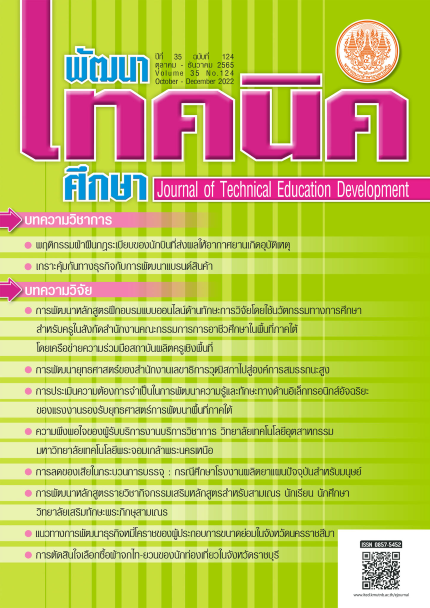พฤติกรรมฝ่าฝืนกฏระเบียบของนักบินที่ส่งผลให้อากาศยานเกิดอุบัติเหตุ
Main Article Content
บทคัดย่อ
บทความวิชาการฉบับนี้ มุ่งเน้นเรื่องการปรับพฤติกรรมผ่าฝืนกฎระเบียบของนักบิน เพื่อเป็นแนวทางและข้อเสนอแนะในการลดจำนวนการเกิดอุบัติเหตุที่เกิดจากนักบินไม่ทำตามกฎระเบียบ เนื่องจากในปัจจุบันการเดินทางด้วยเครื่องบินได้รับความนิยมเพราะสะดวกรวดเร็วและประหยัดเวลา จึงทำให้มีบุคคลจำนวนมากที่ต้องการเดินทางด้วยเครื่องบินและขนส่งสินค้าทางอากาศ ทำให้การเกิดอุบัติเหตุในแต่ละครั้งสร้างความเสียหายต่ออุตสาหกรรมการบินและบุคคลที่เกี่ยวข้องเป็นจำนวนมากแต่ทว่าสาเหตุของอุบัติเหตุส่วนใหญ่เกิดขึ้นจากนักบินที่มีพฤติกรรมฝ่าฝืนกฎระเบียบ ทั้งการทำการบินโดยไม่ทำตามกระบวนการที่ถูกต้อง ดื่มเครื่องดื่มที่มีแอลกอฮอล์ก่อนทำการบิน ทำการแก้ปัญหาด้วยตนเองโดยไม่ฟังความคิดเห็นของลูกเรือหรือเจ้าหน้าที่ควบคุมการจราจรทางอากาศ จนเป็นเหตุให้ไม่สามารถแก้ไขสถานการณ์ได้ทันเวลาและทำให้เกิดอุบัติเหตุจากการศึกษาพบว่า วิธีการปรับพฤติกรรมฝ่าฝืนกฎระเบียบของนักบิน โดยใช้เทคนิค Flooding เป็นวิธีการที่เหมาะสมที่สุด เนื่องจากเป็นเทคนิคที่สามารถนำมาประยุกต์ใช้กับการฝึกบินที่นักบินต้องทำเป็นประจำได้ นอกจากนี้ยังส่งเสริมให้นักบินทำตามกฎระเบียบ ทำให้องค์กรด้านการบินสามารถนำมาปรับใช้กับนักบินของตนได้ เพื่อแก้ไขพฤติกรรมฝ่าฝืนกฎระเบียบของนักบิน พร้อมทั้งเป็นการเพิ่มความเชื่อมั่นของผู้โดยสารและบุคคลที่เกี่ยวข้องในด้านความปลอดภัย
Article Details

อนุญาตภายใต้เงื่อนไข Creative Commons Attribution-NonCommercial-NoDerivatives 4.0 International License.
เอกสารอ้างอิง
Shappell, S., & others. (2007). Human error and commercial aviation accidents: an analysis using the human factors analysis and classification system. Human factors, 49(2), 227-242.
Shappell, S. A., & Wiegmann, D. A. (1997). A human error approach to accident investigation: The taxonomy of unsafe operations. The International Journal of Aviation Psychology, 7(4), 269-291.
Wiegmann, D. A., & Shappell, S. A. (2001). Human error analysis of commercial aviation accidents
using the human factors analysis and classification system (HFACS) (No. DOT/FAA/AM-01/3,). United
States. Office of Aviation Medicine.
Kelemen, M., & others. (2019). Experimental verification of psychophysiological performance of a selected flight personnel and SW: presurvey for transport safety. Transport problems, 14.
ICAO, A. (2011). 1, Personnel Licensing. International Standards and Recommended Practices, Montreal,Canada.
Mackenzie, D. (2010). ICAO: a history of the international civil aviation organization. University of
Toronto Press.
Bolton, M. L., & Bass, E. J. (2012). Using model checking to explore checklist-suided pilot behavior.
The International Journal of Aviation Psychology, 22(4), 343-366.
Shappell, S. A,, & Wiegmann, D. A. (2000). The human factors analysis and classification system-HFACS.
Parohinog, D., & Meesri, C. (2015). ICAO-based needs assessment in Thailand's aviation industry: A basis for designing a blended learning program. Procedia-Social and Behavioral Sciences, 208, 263-268.
Xue, Y.,&Fu, G.(2018). A modified accident analysis and investigation model for the general aviation
industry: Emphasizing on human and organizational factors. Journal of safety research, 67, 1-15.
Johnston,A.N., &Maurino, D. E. (1990). Human factors training for aviation personnel. ICAO journal,
(5), 16-19.
Shappell,S.A,, &Wiegmann,D. A. (1998). A human error analysis of general aviation controlled flight
into terrain accidents occurring between 1990-1998. FEDERAL AVIATION ADMINISTRATION OKLAHOMA
CITY OK CIVIL AEROMEDICAL INST.
Maurino, D. E. (1994). Crosscultural perspectives in human factors training: Lessons from the ICAO
human factors program. The international journal of aviation psychology, 4(2), 173-181.
Dumitru, I. M., & Boscoianu, M. (2015). Human factors contribution to aviation safety. Scientific
Research & Education in the Air Force-AFASES, 2015, (1), 49-53.
You, X., Ji, M., &Han, H.(2013). The effects of risk perception and flight experience on airline pilots'
locus of control with regard to safety operation behaviors. Accident Analysis & Prevention, 57, 131-139.


